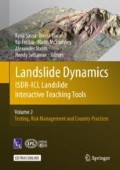Abstract
On August 20, 2014 many landslides and debris flows occurred in Hiroshima city during the heavy rainfall. Ring shear apparatus (ICL-1) was used to simulate the failure of soils, the formation of sliding surfaces and the steady-state motion of Hiroshima landslide disasters. Samples were taken from source area in Midorii and Yagi district. The ring shear tests on Midorii and Yagi samples were carried out under the normal stress of 50 and 100 kPa that assumed the landslide depth from 4 to 8 m. The triggering factor such as pore-water pressure was calculated by using the Slope-Infiltration-Distributed Equilibrium (SLIDE) model that developed by Liao et al. (Landslides 7:317–324, 2010, Environ Earth Sci 55:1697–1705, 2012). The rainfall record monitored at the Miiri JMA station for each 10 min from 8:30 PM on August 19, 2014 was used to calculated pore-water pressure and landslide occurred when pore-water pressure reached 15.2 kPa. All test results were input to an integrated simulation model (LS-RAPID) as dynamic parameter of landslide. The combination of landslide ring shear simulator and integrated landslide simulation model provides a new tool for landslide assessment. The hazard area and time of occurrence in Hiroshima disaster were estimated by LS-RAPID. The estimated hazard area is similar with landslide moving area reported by Geospatial Information Authority of Japan (GSI). This research will contribute to understanding the mechanism of landslide and debris flow during heavy rainfall as a basic knowledge for disaster prevention.
References
Jovančević S, Nagai O, Sassa K, Arbanas Z (2014) Deterministic landslide susceptibility analyses using LS-Rapid software. In: The first regional symposium on landslides in Adrian-Balkan Region, pp 73–77
Liao Z, Hong Y, Wang J, Fukuoka H, Sassa K, Karnawati D, Fathani F (2010) Prototyping an experimental early warning system for rainfall-induced landslides in Indonesia using satellite remote sensing and geospatial datasets. Landslides 7(3):317–324
Liao Z, Hong Y, Kirschbaum D, Liu C (2012) Assessment of shallow landslides from Hurricane Mitch in central America using a physically based model. Environ Earth Sci 55:1697–1705
Montarasio L, Valentino R (2008) A model for triggering mechanisms of shallow landslides. Nat Hazards Earth Sci 8:1149–1159
Sassa K, Fukuoka H, Scarascia-Mugnozza G (1996) Earthquake-induced-landslides: distribution, motion and mechanism. Special issue of soils and foundation, Jpn Geotech Soc, 53–64
Sassa K, Fukuoka H, Wang G, Ishikawa N (2004) Undrained dynamic-loading ring-shear apparatus and its application to landslide dynamics. Landslides 1(1):7–19
Sassa K, Nagai O, Solidum R, Yamazaki Y, Ohta H (2010) An integrated model simulating the initiation and motion of earthquake and rain induced rapid landslides and its application to the 2006 Leyte landslide. Landslides 7(3):219–236
Sassa K, Nagai O, He B, Gradiski K (2013) PDF-tool 3.081-1.2 manual for the LS-RAPID software. ICL landslide teaching tools, p 363, 43 p (pdf) in the attached CD
Sassa K, Dang K, He B, Takara K, Inoue K, Nagai O (2014a) Development of a new high-stress undrained ring shear apparatus and its application to the 1792 Unzen-Mayuyama megaslide in Japan. Landslide 11(5):827–842
Sassa K, He B, Dang K, Nagai O, Takara K (2014b) Plenary: progress in landslide dynamics. In: Sassa K, Canuti P, Yin Y (eds) Landslide science for a safer geoenvironment, vol 1, pp 37–67. Springer
Author information
Authors and Affiliations
Corresponding author
Editor information
Editors and Affiliations
Rights and permissions
Copyright information
© 2018 Springer International Publishing AG
About this chapter
Cite this chapter
Huy, L.D. et al. (2018). TXT-tool 3.081-1.4: Initiation Mechanism of Rapid and Long Run-Out Landslide and Simulation of Hiroshima Landslide Disasters Using the Integrated Simulation Model (LS-RAPID). In: Sassa, K., Tiwari, B., Liu, KF., McSaveney, M., Strom, A., Setiawan, H. (eds) Landslide Dynamics: ISDR-ICL Landslide Interactive Teaching Tools . Springer, Cham. https://doi.org/10.1007/978-3-319-57777-7_6
Download citation
DOI: https://doi.org/10.1007/978-3-319-57777-7_6
Published:
Publisher Name: Springer, Cham
Print ISBN: 978-3-319-57776-0
Online ISBN: 978-3-319-57777-7
eBook Packages: Earth and Environmental ScienceEarth and Environmental Science (R0)

